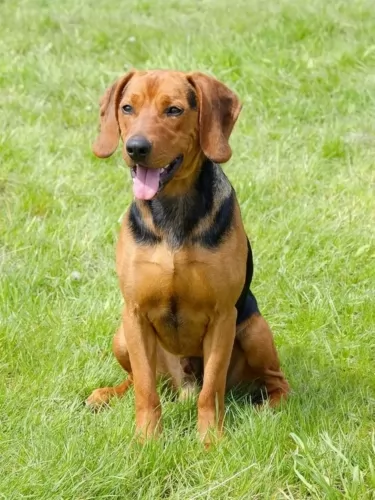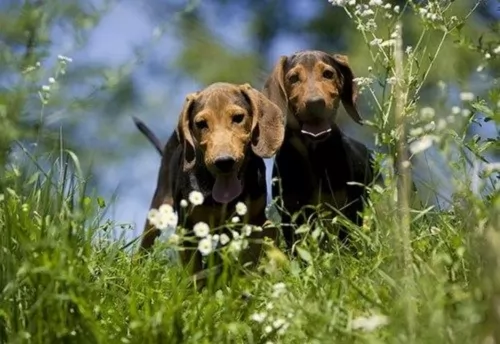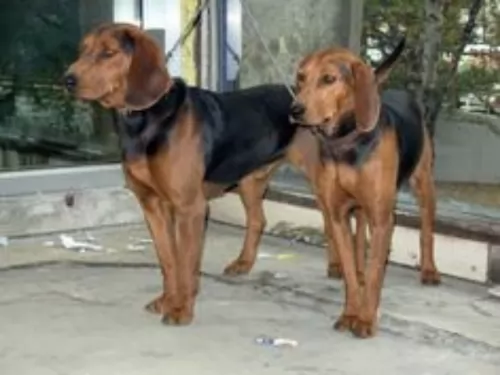 MyDogBreeds
MyDogBreeds Serbian Hound is originated from Serbia but Bloodhound is originated from United Kingdom. Both Serbian Hound and Bloodhound are having almost same height. Serbian Hound may weigh 49 kg / 108 pounds lesser than Bloodhound. Serbian Hound may live 4 years more than Bloodhound. Serbian Hound may have less litter size than Bloodhound. Both Serbian Hound and Bloodhound requires Low maintenance.
Serbian Hound is originated from Serbia but Bloodhound is originated from United Kingdom. Both Serbian Hound and Bloodhound are having almost same height. Serbian Hound may weigh 49 kg / 108 pounds lesser than Bloodhound. Serbian Hound may live 4 years more than Bloodhound. Serbian Hound may have less litter size than Bloodhound. Both Serbian Hound and Bloodhound requires Low maintenance.
 Once known as the Balkan Hound, the Serbian Hound is a scenthound, an ancient dog breed that dates back to the 11th century. He has always been a hunting dog, hunting in packs, but today he is essentially a pet and a companion.
Once known as the Balkan Hound, the Serbian Hound is a scenthound, an ancient dog breed that dates back to the 11th century. He has always been a hunting dog, hunting in packs, but today he is essentially a pet and a companion.
Although the breed is very popular in Serbia, they have not spread much outside of the Balkan region. The first description of the Serbian Hound dates from 1905. The first standard for the dog was published in 1924.
This dog isn’t recognized by the AKC but he has been recognized by the FCI in 1940 and in 2006 by the United Kennel Club.
 The history of the Bloodhound breed is a fascinating one. Known as a Sleuthhound for its ability to smell out the culprit and bag the prey. Even more so the Bloodhound is known for tracking and finding lost people. He is famous for finding human scents and being able to follow them even days or weeks after the person is lost. They are also able to track people over a great amount of land and have been known to successfully track escaped prisoners or wanted criminals. They are descended from the Saint-Hubert Hounds that were bred at the Abbey/Monastery at Saint-Hubert, Belgium. According to the legends the St. Hubert hounds were bred by the Monks in 1000AD. This hound was thought to be a mixed breed rather than a purebred. That’s because the ancestry of this hound is not really known but it is known that the monks bred them and sent several to the King of France annually. Only black hounds were gifted.
The history of the Bloodhound breed is a fascinating one. Known as a Sleuthhound for its ability to smell out the culprit and bag the prey. Even more so the Bloodhound is known for tracking and finding lost people. He is famous for finding human scents and being able to follow them even days or weeks after the person is lost. They are also able to track people over a great amount of land and have been known to successfully track escaped prisoners or wanted criminals. They are descended from the Saint-Hubert Hounds that were bred at the Abbey/Monastery at Saint-Hubert, Belgium. According to the legends the St. Hubert hounds were bred by the Monks in 1000AD. This hound was thought to be a mixed breed rather than a purebred. That’s because the ancestry of this hound is not really known but it is known that the monks bred them and sent several to the King of France annually. Only black hounds were gifted.
Some kings preferred not to hunt with these hounds thinking them not good enough while others thought the only use for them was as a leash hound. All described the St. Hubert as long in body with short legs. These gifts continued until the French Revolution when hunting in France was greatly reduced until the 19th century. The original St. Hubert strain became extinct in the 19th century and that the current European St. Hubert hound has its origins in the Bloodhound. The Bloodhound as a separate breed was already established in Europe by the middle of the 14th century. They were used as leach hounds to sniff out the prey so that the pack hounds could chase and keep it “at bay”. They were also used from the beginnings of the breed to track humans. At this time they were often known as sleuth hounds. As recorded by John Caius – the authority on Bloodhounds from their origins – writes about the breeds ability to find and track the scent of blood – thus becoming the Bloodhound and its use to track poachers and thieves. He also reported that the Bloodhound and the Sleuth Hound were the same basic breed. The number of Bloodhounds in Britain gradually declined until few remained after World War II. Britain has gradually built their breed back up by importing dogs from America. It was during the 19th century that the Bloodhound was imported into France by breeders who wished to reestablish the St. Hubert Hound. Thus the St. Hubert is both the ancestor and descendent of the Bloodhound. The Britain’s continue to believe that the Bloodhound is a native British breed.
The Bloodhounds in America have had great success as companion animals, with police departments and forest rangers and showing in the prestigious Westminster Kennel Club in New York. There are more Bloodhounds in the United States than anywhere else in the world.
In the end the Anglo-Saxton Bloodhound cannot be specified with any real certainty. Many believe it was not the St. Hubert that the Bloodhound descended from but rather the Norman hound or the sleuth-hound. Many believe it could have included other breeds such as the southern hound, the dun-hound and the Talbot. It cannot be proven today it the Bloodhound’s origins come from Belgian or England.
 The Serbian Hound isn’t a particularly large dog. He is medium sized, standing at between 44 to 56cm in height and weighing in the region of 11 to 23kg. The coat of the dog is a red or tan color with a black saddle.
The Serbian Hound isn’t a particularly large dog. He is medium sized, standing at between 44 to 56cm in height and weighing in the region of 11 to 23kg. The coat of the dog is a red or tan color with a black saddle.
The hair is short, thick and shiny with the hair being slightly longer over the thigh area. The ears are high set, are of medium length and are floppy. The average litter size for these dogs is 3 to 6 puppies.
The good-natured Serbian Hound makes a loving and devoted pet. He’ll get on well with children too. They’re friendly dogs with a relaxed disposition, but to maintain that easy going characteristic, they will need to be well exercised.
They’re intelligent dogs with an independent side to them, and some training and socialization will be recommended.
 When being judged for confirmation in a show ring, the preference is for a larger dog, with an unusual skeleton in respect to its large size and heavy weight in the bones. They have a narrow head, flat at the sides, but long. They have deep set eyes buried in the deep, long face and wrinkles. The eyes might be yellow or run the gamut to deep hazel depending upon the color of the dog. The long velvety ears and thin and low set on the head. These long ears are as much a part of the Bloodhounds Olfactory system as his amazing nose. They curl backward and inward as the ends. There is a large amount of loose skin on the head and at the jowls. When the Bloodhound lowers his head the loose folds and ridges of skin are prominent on the face and forehead.
When being judged for confirmation in a show ring, the preference is for a larger dog, with an unusual skeleton in respect to its large size and heavy weight in the bones. They have a narrow head, flat at the sides, but long. They have deep set eyes buried in the deep, long face and wrinkles. The eyes might be yellow or run the gamut to deep hazel depending upon the color of the dog. The long velvety ears and thin and low set on the head. These long ears are as much a part of the Bloodhounds Olfactory system as his amazing nose. They curl backward and inward as the ends. There is a large amount of loose skin on the head and at the jowls. When the Bloodhound lowers his head the loose folds and ridges of skin are prominent on the face and forehead.
For many centuries all different colors of Bloodhounds could be found. Today however they are pretty much red, black and tan and black and liver. The Bloodhound is a powerful dog and is larger than most breeds of hounds.
 The Serbian Hound is a working dog that just loves being busy, and he can keep busy for a long time as he has plenty of stamina.
The Serbian Hound is a working dog that just loves being busy, and he can keep busy for a long time as he has plenty of stamina.
He is an easy going dog, laid back, social and lively as well as being loving and loyal. They’re independent and strong-willed as well as being intelligent. You shouldn't have any difficulty training and socializing him, and it will round your pet off nicely, making him an even better companion and pets.
 The Bloodhound is known as a gentle soul and he truly is. They are affectionate and gentle with people and children. However, their strong will to track can make them stubborn and hard to handle and train. They are easy going dogs and really like to be with people, children and other dogs. They are affectionate but tend to be set in their ways.
The Bloodhound is known as a gentle soul and he truly is. They are affectionate and gentle with people and children. However, their strong will to track can make them stubborn and hard to handle and train. They are easy going dogs and really like to be with people, children and other dogs. They are affectionate but tend to be set in their ways.
 Your Serbia Hound can live to be 12 to 15 years of age, but just like with other dogs, he will need to be watched for some of the common dog diseases there are. Cancer, bloat, skin infections and kennel cough are all diseases to look out for.
Your Serbia Hound can live to be 12 to 15 years of age, but just like with other dogs, he will need to be watched for some of the common dog diseases there are. Cancer, bloat, skin infections and kennel cough are all diseases to look out for.
Ear infections are common in dogs with floppy ears. You need to check inside your dog’s ears as an ear infection can be a painful condition. You’ll see your dog scratching at his ears and shaking his head.
Most ear infections are caused by bacteria and yeast or even ear mites. You can’t play around with an ear infection and the veterinarian will take a sample from the affected ear. Most people don’t like to fiddle around with the inner ear and prefer to leave this grooming part to the vet or a professional groomer.
 Obviously with ears like the Bloodhound there is always a chance for problems and serious infections. The ears need to be cleaned daily. Because their coat is so thick, they can overheat easily, and they are very prone to bloat, as are many large animals. However, with the Bloodhound, Bloat is the number one killer. Their lifespan is one of the shortest of all dogs at 6.75 years.
Obviously with ears like the Bloodhound there is always a chance for problems and serious infections. The ears need to be cleaned daily. Because their coat is so thick, they can overheat easily, and they are very prone to bloat, as are many large animals. However, with the Bloodhound, Bloat is the number one killer. Their lifespan is one of the shortest of all dogs at 6.75 years.
 Serbian Hounds with their short coats are low maintenance. Yes, they do shed throughout the year, and have some seasonal shedding. A good brush twice a week will be adequate for this dog.
Serbian Hounds with their short coats are low maintenance. Yes, they do shed throughout the year, and have some seasonal shedding. A good brush twice a week will be adequate for this dog.
Check your Serbian Hound’s ears and eyes for infection. Also, as you brush him, take note of any new or unusual lumps you come across.
As a medium-sized dog, if you choose to feed your dog kibble, it will need to be according to size, his age and activity levels. Read the labels carefully to make sure you know how to feed your Serbian Hound the best way.
Choose kibble that has a good selection of vitamins and minerals in it. Try and provide your pet with some home made food too and add it twice a week to the dry kibble to give him some variety and a tasty treat.
Boiled chicken, brown rice, sweet potatoes, carrots and spinach are simple foods – good for a dogs digestion. By also adding a bit of raw meat to his food you help him maintain a healthy coat and skin.
As a hunting breed, this dog has a lot of stamina and energy. He is going to require a good deal of exercise every day. Walks are always a good thing but he’ll want more energetic action – runs, ball games and some swimming.
Toys and equipment that can provide him with mental stimulation will be good for him too as he is a mentally sharp dog.
 The Bloodhound is not a high energy, fast moving dog but that does not mean he doesn’t have serious nutritional needs. An overweight Bloodhound is on a course to an early demise. They should be fed a high-quality food once a day or split into two daily servings. Do not feed them right before or right after strenuous exercise and remember that strenuous exercise for a Bloodhound is considerably less than it is for a terrier.
The Bloodhound is not a high energy, fast moving dog but that does not mean he doesn’t have serious nutritional needs. An overweight Bloodhound is on a course to an early demise. They should be fed a high-quality food once a day or split into two daily servings. Do not feed them right before or right after strenuous exercise and remember that strenuous exercise for a Bloodhound is considerably less than it is for a terrier.
As previously mentioned the number one cause of death in Bloodhounds is Bloat. They are also prone to cancer. They have minor issues with their eyes, but their ears and skin are also major concerns. Clean the ears daily and wipe out the skin folds and wrinkles to prevent infections. They should be test for hip and elbow dysplasia simply because they are large dogs, though these conditions are less common in Bloodhounds.
Though the Bloodhound is known as a couch potato his stamina and activity levels are usually greatly underestimated. He can follow a scent for 7-10 hours over miles of terrain with out a problem. He needs daily exercise such as long walks on a leash. Do not take your Bloodhound out off leash because if he picks up a scent and wanders off you will not be able to get his attention to call him back.